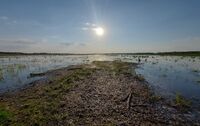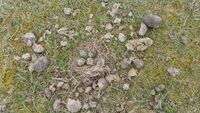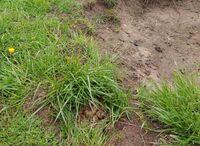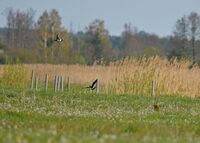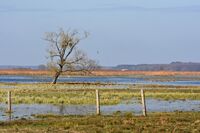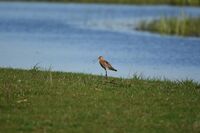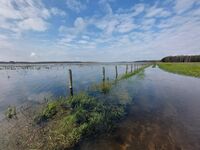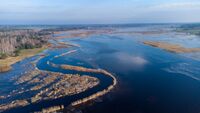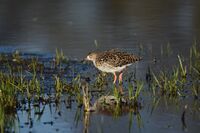Monitoring of Charadriiformes birds in the upper Narew Valley
We counted breeding Lapwings, Redshanks, Black-tailed godwits and Ruffs as part of our monitoring of Charadriiformes birds in the upper Narew Valley. In the section between the Narew River and Ploski, we found a total of 105-117 pairs of Lapwings, 21-25 pairs of Redshanks, and 3-4 breeding pairs of Black-tailed godwits. These results confirm that our activities, primarily grazing, are having a beneficial effect on the habitats of the listed species.
The most numerous Lapwings obtained the highest densities in the pastures in the area of Puchly and Trześcianka— in the area where we have restored habitat, and we continue these activities under the current project. The birds were eager to nest near last year's horse droppings or to incorporate breeding in them. The positions of the Redshank were always near the nesting sites of the Lapwing. The nests found were generally well sheltered, most often in undersized clumps of grass and near water. Observations of nesting Black-tailed godwits were very few and scattered. Unfortunately, in the case of this species, if there was an egg, the loss of breeding must have occurred at an early stage. Of the monitored Charadriiformes, the only species whose nesting we did not record this season was the Ruff. In May, however, one female was observed near Trześcianka, which may indicate a breeding attempt.
Pastures near Trześcianka, the site of our project, concentrated as much as 38% of the population of monitored species in the studied section of the valley. In an area of about 110 hectares, we found 38-42 breeding pairs of Lapwings, 8 pairs of Redshanks, and 1 pair of Black-tailed godwits. This means a density of the surveyed Charadriiformes of 4.4 p/10 ha, with Lapwing alone at 3.6 p/10 ha.
The results obtained in 2023 indicate that the identified counts of Charadriiformes are the highest or close to the highest that have been shown in the area in the past two decades. One of the reasons for this was the relatively high level of spills in the spring of 2023 in this section of the valley. The second factor behind the increase in breeding populations was the restoration of grassland and pasture use by the PTOP. It is currently one of only two sites in the valley where nesting Charadriiformes are colonial in nature. Pastures with a varied spatial structure, with a wide range of meadow and sedge communities that are gnawed by cattle and horses, combined with broads and oxbow lakes that form a mosaic, are key elements of breeding habitat for the monitored species.
In addition to providing optimal nesting habitat, breeding success at a level that ensures at least generation replacement is a necessary factor in maintaining stable bird populations. Unfortunately, there are a number of predatory species in the valley section in question, which have a significant impact on the breeding success of ground nesting birds. Therefore, the next and main activity of this project will be the construction of an anti-predator fence in the area of Trześcianka, it will cover 60 hectares of pastures. We are starting soon, hence the fence will be ready in the spring.
The inventory on behalf of PTOP was carried out by ornithologists from TowarzystwoPrzyrodniczeDubelt (Dubelt Nature Society).
Photos:Grzesiek Grygoruk, Piotr Świętochowski, Tomasz Tumiel

